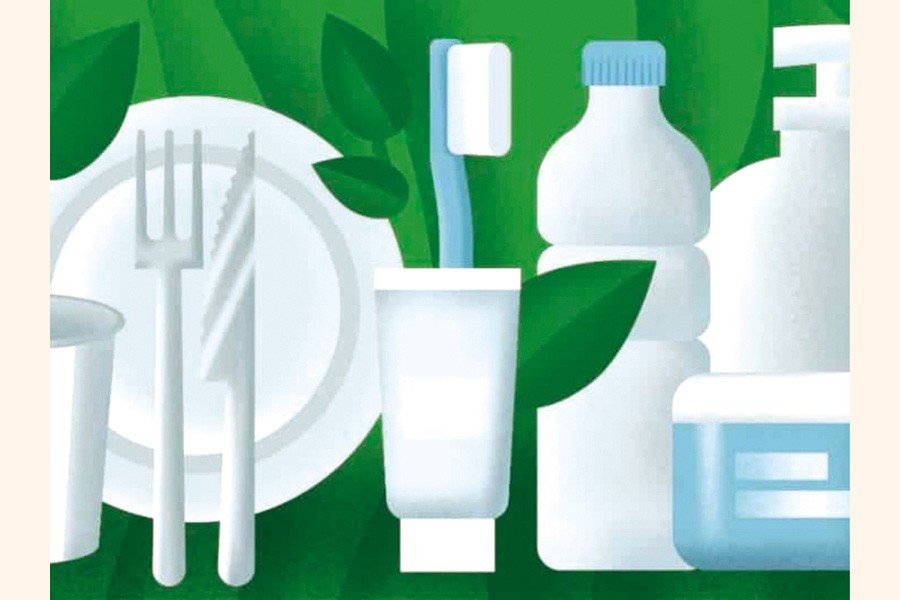Tanannum Azad Arufa and Sabit Ibtisam Anan | December 10, 2023 00:00:00

 An alarm bell rings that, under "business as usual" levels, plastic pollution is set to double by 2040, whilst consumption likely to double by 2050. In recent years, the rapid proliferation of plastics production, primarily single-use plastics, has resulted in an alarming 8.3 billion metric tonnes of plastic waste, contributing to a total production of 430 million tonnes as of 2023. The ecological impact of plastic, from micro-and marine-plastic pollution to bioaccumulation of toxic substances, poses a severe problem that the international community has been scrambling to solve for decades.
An alarm bell rings that, under "business as usual" levels, plastic pollution is set to double by 2040, whilst consumption likely to double by 2050. In recent years, the rapid proliferation of plastics production, primarily single-use plastics, has resulted in an alarming 8.3 billion metric tonnes of plastic waste, contributing to a total production of 430 million tonnes as of 2023. The ecological impact of plastic, from micro-and marine-plastic pollution to bioaccumulation of toxic substances, poses a severe problem that the international community has been scrambling to solve for decades.
One of the results of this pursuit has been the emergence of bioplastics, a substitute for plastics, which supposedly address many of the issues posed by plastics. But how much of this is academic flair with no industry applications? And do bioplastics really provide a promising solution to this problem?
To explore the answer to that question, we first must understand what bioplastics are and what differentiates them from traditional plastic. When we talk about "traditional plastic", we mean petrochemical plastic created from crude oil or natural gas. The brunt of GHG emission from plastics, more than 90 per cent, comes from the production of petrochemical plastic from fossil fuels. This translates to more than 1.6 billion metric tonnes of carbon dioxide equivalent (GtCO?e). On the other hand, bioplastics refer to plastic derived from biological resources like corn, sugarcane or oilseeds.
However, the first challenges of bioplastics start to emerge here. Before anything, the use of bioplastics as a catch-all term has been a cause of confusion and exploitation, as many producers indiscriminately abuse the sustainable tagline to greenwash their products. Generally, it is considered that plastic having 20-percent bio-based material qualifies as bioplastic. Currently, there are predominantly two types of bioplastics: PLA (made from corn starch, sugarcane etc) and PHA (made from carbon reserves of microorganisms). PLA is primarily used in packaging, plastic cutlery and textiles. In contrast, PHA is a good alternative to single-use plastic, with significant applications in the field of medical equipment as well.
The second challenge stemming from bioplastics is agricultural carbon footprint. Yes, the raw material may not be derived from fossil fuels, but it is still being derived from agricultural products, with a significant carbon footprint. This carbon footprint relates to land use, fertiliser use and emissions from agricultural-residue composting. However, researchers conclude that this is still better than conventional plastics, reducing emissions of up to 13 tonnes of CO2 equivalent per hectare.
Food crops being used as natural bases for bioplastic pose a resource-insufficiency challenge as well. Global agricultural-land use peaked after 2000 and has declined since the start of this century. Global warming and changing climate have been exacerbating food crises in many regions of the world, so using agricultural land/food crops to make bioplastics may cause further food shortages. For instance, to replace the EU's plastic packaging with bioplastics, 30 per cent of global production of castor beans would need to be rerouted.
Are bioplastics really biodegradable?: The third, and arguably the biggest, challenge of bioplastics is about biodegradability. While that sounds oxymoronic, contrary to various myths, bioplastics often don't quite have a smooth biodegradation process. Many types require specific conditions like heat, microbes or moisture to degrade, which may not be available in a landfill or composting site. Bioplastics breaking down can cause harm to human health and the environment as well. As one study puts it, the impact of bio-HDPE on human health is estimated to be 50 times higher than conventional HDPE.
The infrastructure required to sustain bioplastic recycling and End-of-Life(EOL) treatment isn't in place yet, and mixed streams of disposal can be severely damaging to the environment. The recycling process of conventional plastic is also hampered when bioplastic is not separated properly. The lack of necessary infrastructure and capacity forces us to re-evaluate how sustainable a transition to bioplastics really would be. Research and standardisation are essential to ensure that more harm than good is not done.
Economic constraints and use-case limitations: From the viewpoint of scaling, the primary drawback of bioplastics is higher production cost. Bioplastics currently hold a minuscule market share, accounting for just one per cent of the 200-million-tonne per-year global plastic market. The fact that bioplastics are 20-to 50percent more expensive than conventional plastics doesn't help this in any way. This cost disparity is due to their early commercialisation stage and the complex process used to convert corn or sugarcane into the building blocks for PLA (Polylactic Acid). The nascent bioplastic industry has higher fixed costs per unit, as it relies heavily on the supply and price of biomass and the development of infrastructure and technology. This economic landscape places bioplastics at a competitive disadvantage.
Despite the higher price tag compared to their fossil-based counterparts, bioplastics may not exhibit the same level of mechanical strength, thermal stability or gas-barrier properties, limiting their use in specific industries where these properties are paramount. Such limitations require careful consideration when choosing between bioplastics and traditional plastics.
Whether or not to just abandon bioplastics:
Bioplastic may be expensive, with a significant amount of not-entirely-true marketing to its name, yet the research being done in this field is constantly making strides. The infrastructure issue is being resolved slowly, with adaptive recycling centres, multi-layered waste-separation processes and investments in disposability research. Better production processes that are more economically sustainable are being developed regularly by early-stage startups and research teams. Most importantly, bioplastics are already a part of the circular economy, unlike Virgin Plastics, because they are often made from waste and residue.
After all this, the future of bioplastics is actually rather bright. This field of academia is vibrant, with new research and breakthroughs occurring constantly, and it's viable to assume that many of the challenges of current bioplastic will be rooted out gradually. For example, if we are to address the use-case limitation issue through reinforcing bioplastics with different materials, such as lignocellulosic fibre, synthetic fibre, cellulose, starch, clay, CNT, or blending with other polymers, the physical, chemical, thermal, and mechanical properties can be significantly improved.
Some projects today are also working to address the agricultural carbon-footprint challenge, like California-based company 'Full cycle Bioplastic' producing PHA from organic waste like food waste and crop residue. Again, another startup from the same region, 'Mango Material', is transforming methane gas from landfills into bioplastic. When implemented on an industrial scale, these initiatives will induce more circularity than conventional first-generation bioplastics.
Bioplastics are by no means a silver bullet to fight plastic pollution, and over-reliance without standardisation will only bring more harm than good. A rational approach towards bioplastic, based on research and ecological-sustainability markers, can help by solving many of conventional plastic's problems and its own.
Tanannum Azad Arufa and Sabit Ibtisam Anan are passionate researchers in sustainability, climate resilience and adaptability. Reach out to them at tanannumazad@gmail.com and sabitanan007@gmail.com
© 2025 - All Rights with The Financial Express
